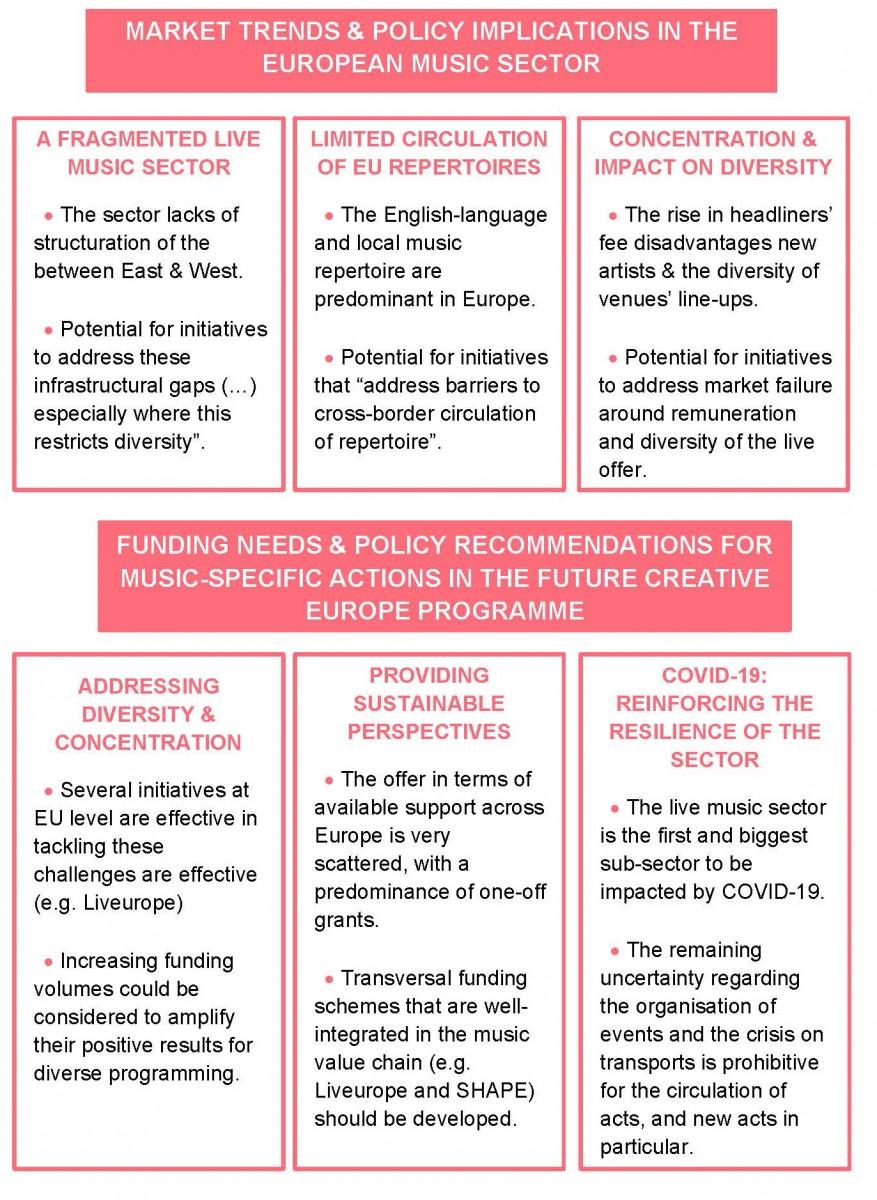
New EU study calls to amplify the budget of platform calls for the European live music sector within the future Creative Europe programme

The EU recently published two studies under the Music Moves Europe Preparatory action, one of which focuses on an ‘Analysis of market trends and gaps in funding needs for the music sector’. Among its key policy recommendations, this study includes as a priority to increase the financing volumes for initiatives that are effective in tackling concentration and in promoting diversity, such as the Liveurope platform.
Main trends identified and policy implications for the European live music sector
Similarly to the European Music Export Strategy Study that was published by the EU at the beginning of the year, this new study confirms the domination of the English-language and local repertoire in Europe. Though European repertoire is highly diverse, it is limited in circulation, showing the way for initiatives that “address barriers to cross-border circulation of repertoire”.
This is particularly true for the live music sector, that is characterised by its fragmentation and lack of structuration between the east and the west of Europe. The policy implication that ensues from this is the “potential for initiatives to address these infrastructural gaps (…) especially where this restricts diversity”.
The study also underlines the ever-growing concentration trends and their impact on the diversity of programming for the live music sector. The increase in fees for headliners “often entails a lower fee for emerging artists (…) and is often preventing middle to large music venues to programme independently, (….) resulting in a homogenisation of line-ups”. This consequently opens “a potential for initiatives to address market failure around remuneration of emerging artists and diversity of the live offer on key platforms (festivals, major venues)”.
“Overall, this EU study objectively analyses many of the intuitions that guided the creation of our platform. In this, it also stresses the importance of the challenges we wanted to tackle when we elaborated our own bonus system to incentivise music venues to take more risks and book new European acts from unchartered territories” emphasizes Liveurope coordinator Elise Phamgia.
Policy recommendations and funding needs to address concentration, promote diversity and sustainable perspectives in the European music sector
Following this analysis and an extensive mapping of the funding opportunities for the music sector in Europe, the study looks into its main funding needs.
In echo to the concentration issue and the decreasing diversity on European live events, the study points at the efficiency of initiatives like Liveurope to tackle these challenges. “While there is no funding gap per se, increasing funding volumes could be considered in order to amplify their positive results for diverse programming.”
“Thanks to the cascading grant system, our venues across the continent are provided with a simple, unique and progressive tool to continuously boost our European programming from one season to the next. Liveurope has changed our programming approaches and gave our audiences access to new acts they might not have discovered otherwise” comments Matjaž Manček, artistic director at Kino Šiška, Slovenian member venue of Liveurope.
On average, the platform members have increased by 63% the number of new European acts they book in comparison to pre-Liveurope.
In addition and to overcome the scattered offer in terms of available support and funding mechanisms across Europe, the study recommends to focus on the “development of transversal funding schemes that are well-integrated in the value chain of the different music subsector (e.g. Liveurope and SHAPE) rather than multiplying the grant possibilities”.
Drawing upon this funding gap analysis, the study proceeds with a series of final policy recommendations. Among its concrete proposals for music-specific actions to be taken under the future Creative Europe programme, the budget expansion for platform calls is distinctly highlighted as a key priority.
“The conclusions of this study are crystal clear: there is a potential at EU level to leverage the impact of initiatives like ours. By increasing their budgets to include a greater number of live music venues, there is an opportunity to create a level playing field and increase Europe’s musical diversity“ remarks Tom Bonte, Director of Ancienne Belgique, Liveurope’s coordinating venue.
While the consequences of the COVID-19 crisis cannot be fully assessed yet, the study points to a few elements showing that some of these challenges and funding needs are now exacerbated, and the pandemic enhances the urgency to address them.
As “the first and biggest sub-sector” to be impacted, live music is faced with substantial economic losses and high unemployment rates. The remaining uncertainty regarding the organisation of concerts and the crisis on the transport sector are prohibitive for the circulation of artists and especially emerging ones.
“Booking new European bands was already a significant financial risk for our venues, and the crisis will make it harder to fuel the progression curve we have achieved without additional support” declares Tom Bonte.
Arthur Le Gall, Director of KEA, the consultancy leading the report adds “throughout our research, Liveurope distinguished itself as a good example of how to efficiently allocate EU funding to the sector with barely no administrative burden for the stakeholders involved.”
“Future action for music at EU level should also focus on developing this type of financial engineering and scaling up its scope to best cater the sector’s needs – and we saw a high demand for such type of calls under Creative Europe. This is particularly important for a sector populated with a myriad of smaller operators with great ideas but little resources to launch initiatives at EU level.” Arthur Le Gall continues.
“If the €2,2 billion Creative Europe budget for 2021-2027 is confirmed, we have a true momentum to provide the European Music sector with ambitious, smart and efficient tools to improve our diversity, our resilience and our competitiveness in the years to come” concludes Elise Phamgia.
Table: Liveurope's key takeaways from the EU Study "Analysis of market trends and gaps in funding needs for the music sector (2020)"




























